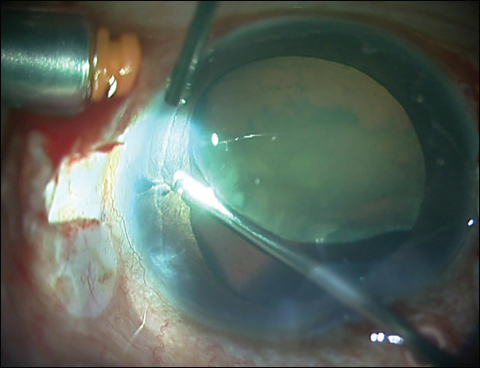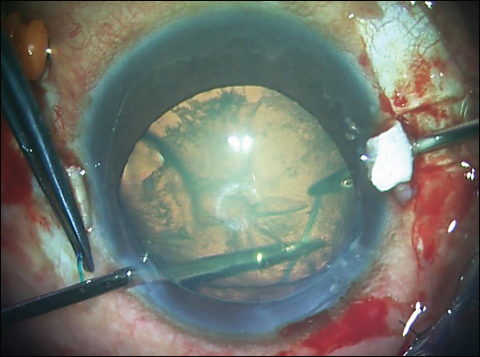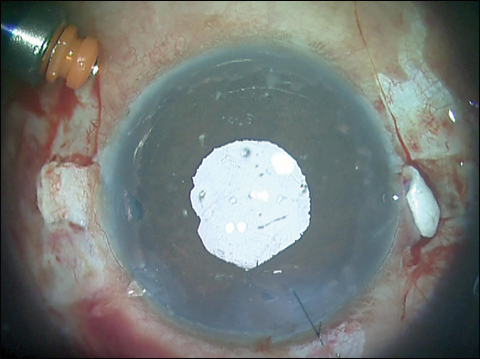Glued IOL scaffold can be used in massively subluxated IOL cases
In these cases with deficient sulcus support and an intraoperative posterior capsule rupture, the technique facilitates nuclear emulsification with secondary IOL fixation.
Phacoemulsification relies on the presence of an intact posterior lens capsule for safe completion of the procedure, leaving an intact posterior lens capsule for the insertion of a posterior chamber IOL. The posterior lens capsule thus functions as a relative barrier during the surgical procedure to keep the lens fragments within the anterior segment and preventing unwanted entry into the posterior vitreous cavity and onto the retina. However, the cataract surgeon may face a challenging case in which zonular dehiscence, or its relative absence for any reason, results in a cataract that may be associated with vitreous from the posterior vitreous cavity entering the anterior chamber around the subluxated cataractous lens. In these difficult surgical cases, even the most careful phacoemulsification procedure risks the possibility of lens fragments being dropped into the vitreous. In such cases, a posterior support behind the cataractous lens can afford the added security in retaining the lens fragments within the confines of the anterior segment and prevent their entry into the posterior vitreous cavity. An anterior vitrectomy is usually required whenever vitreous presents into the anterior chamber.
Careful, comprehensive preoperative evaluation of both the anterior and posterior segments before undertaking phacoemulsification in cases of subluxated cataract is essential in adequately planning and executing safe cataract surgery. In such cases, preoperative evaluation often includes corneal endothelial cell count and pachymetric measurements, the latter to assess the endothelial functional status. In addition, the presence or absence of vitreous in the anterior chamber or in the pupillary area should be noted in the patient records. Also, the iris, pupil and anterior chamber angle should be assessed. If there are any anterior or posterior synechiae, these should be taken into account in the surgical planning of the case. Lastly, the posterior segment should be assessed, namely the macula, optic nerve and peripheral retina.
In this column, Drs. Narang and Agarwal describe a glued IOL scaffold as a protective shield during phacoemulsification to provide added surgical safety in a case of a prominent subluxation of the lens with vitreous presence within the anterior chamber.
Thomas “TJ” John, MD OSN Surgical Maneuvers Editor


Glued IOL scaffold is a procedure that encompasses glued IOL and IOL scaffold techniques together and is applicable in cases with inadequate sulcus support in the presence of nonemulsified nuclear fragments. The technique thrives on the basic principle that for nucleus emulsification a barrier or a support is needed to prevent the nucleus from falling down into the vitreous cavity. In normal cases, the posterior capsule provides this support, whereas in cases with intraoperative posterior capsule rupture (PCR), this support is lost. Hence, in such cases with deficient sulcus support and a PCR, the technique of glued IOL scaffold facilitates nuclear emulsification with secondary IOL fixation.
The technique of glued IOL scaffold is also applicable in cases with massively subluxated IOLs (Figure 1) that have fewer zonules for support and also in cases with aphakia associated with Soemmering’s ring.
Surgical steps and technique
After a PCR, the surgery is halted and an ophthalmic viscosurgical device is injected from the side port to prevent the collapse of the globe before the withdrawal of the phacoemulsification probe. After the phaco probe is withdrawn, two partial-thickness scleral flaps are made 180° opposite to each other. Fluid infusion is introduced inside the eye with a trocar cannula, a trocar anterior chamber maintainer or an anterior chamber maintainer, taking care to direct the flow of fluid so that it does not push the fragments into the posterior chamber. A limited vitrectomy is performed beneath the nucleus (Figure 2) or the nuclear fragments so as to avoid any vitreous traction while the IOL is unfolding and the haptics are being externalized. A three-piece foldable IOL is loaded into the cartridge that is introduced inside the anterior chamber so that the IOL can unfold beneath the nucleus.

Source: Priya Narang, MS, and Amar Agarwal, MS, FRCS, FRCOphth







Glued IOL forceps (end-opening forceps) are introduced from one sclerotomy site, and the tip of the leading haptic is grasped as the IOL unfolds beneath the nucleus (Figure 3). The leading haptic is then pulled and externalized. The trailing haptic is flexed inside the eye and maneuvered beneath the nucleus. The handshake technique is performed beneath the nucleus (Figure 4), and the tip of the trailing haptic is pulled and externalized. The haptics are tucked inside the scleral pockets that are created with a 26-gauge needle.
At this stage, the optic of the IOL forms an artificial posterior capsule above which the nucleus can be emulsified. A phaco probe is introduced inside the anterior chamber, and the nucleus is then emulsified (Figure 5). Once the entire nucleus is emulsified, checking the amount of haptic tuck on either side reinforces the stability of the IOL. Pupilloplasty is often performed when glued IOL is being done for eyes with a larger white-to-white diameter. This prevents optic capture, which can occur due to the anterior shift of the IOL plane due to fashioning of the anterior sclerotomy in order to have greater haptic length exteriorization.
We prefer to perform the single-pass four-throw technique for pupilloplasty (Figure 6) because only a single pass is needed for performing this technique instead of the conventional two passes that are necessary in other techniques.
Once IOL fixation is achieved and the nucleus is emulsified (Figure 7), the fluid infusion is removed and the scleral flaps are sealed with fibrin glue. Intrascleral fixation imparts stability to the IOL, and good postoperative results (Figure 8) are achieved if all the nuances of the surgical technique are focused upon.
Surgical pearls
- Fluid infusion is a must for performing this procedure in order to prevent the collapse of the globe due to vitreous loss.
- The flow of fluid should be directed parallel to the surface of the iris plane if an anterior chamber infusion is employed.
- Glued IOL is performed initially so that the optic of the IOL forms the base above which the nucleus can be emulsified subsequently with a phacoemulsification probe, as in an IOL scaffold.
- The optic of the IOL should be laid beneath the nucleus. If the IOL unfolds above the nucleus, the optic should be maneuvered at the optic-haptic junction with a Sinskey hook and dragged aside with the simultaneous maneuvering of the nucleus and its fragments from the side-port incision so as to place them above the IOL optic.
- During nuclear emulsification, the nuclear fragments can drop from the edges of the IOL into the vitreous cavity. Under such circumstances, if iris hooks are being used, they should be released and the iris should be allowed to fall back to its normal position. The iris tissue around the optic prevents any slippage of fragments into the vitreous cavity. If hooks are not employed, then the iris can be tapped so as to constrict it mechanically. Nevertheless, the nuclear pieces should be directed toward the phaco probe with the chopper or the side instrument so that they are effectively emulsified without any slippage.
- The procedure is not performed in cases with grade 4 dense cataracts or in cases with low endothelial cell counts.
- References:
- Agarwal A, et al. J Cataract Refract Surg. 2008;doi:10.1016/j.jcrs.2008.04.040.
- Agarwal A, et al. J Cataract Refract Surg. 2013;doi:10.1016/j.jcrs.2013.01.018.
- Agarwal A, et al. J Cataract Refract Surg. 2013;doi:10.1016/j.jcrs.2013.01.019.
- Narang P, et al. Ophthalmology. 2013;doi:10.1016/j.ophtha.2013.05.011.
- Narang P, et al. J Cataract Refract Surg. 2015;doi:10.1016/j.jcrs.2015.02.020.
- Narang P, et al. J Cataract Refract Surg. 2015;doi:10.1016/j.jcrs.2015.10.035.
- For more information:
- Amar Agarwal, MS, FRCS, FRCOphth, can be reached at Dr. Agarwal’s Eye Hospital, 19 Cathedral Road, Chennai 600086, India; email: dragarwal@vsnl.com.
- Priya Narang, MS, can be reached at Narang Eye Care & Laser Centre, Ahmedabad, India; email: narangpriya19@gmail.com.
- Edited by Thomas “TJ” John, MD, a clinical associate professor at Loyola University at Chicago and in private practice in Oak Brook, Tinley Park and Oak Lawn, Ill. He can be reached at email: tjcornea@gmail.com.
Disclosures: Agarwal, Narang and John report no relevant financial disclosures.
